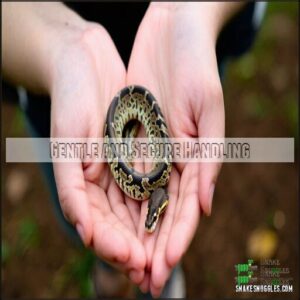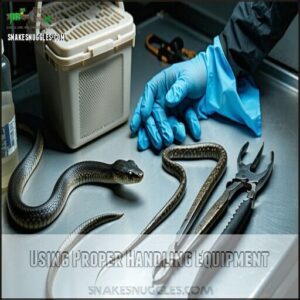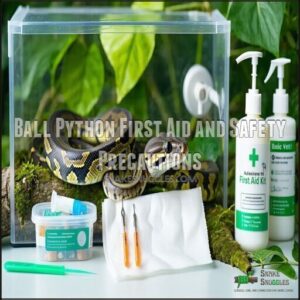This site is supported by our readers. We may earn a commission, at no cost to you, if you purchase through links.

Always come from the side, not above, as overhead motions can startle them.
Gently slide your hand under its middle section, supporting its body fully with both hands.
Never grab its neck or tail, as this can cause stress or injury.
Keep your grip firm but not tight, allowing the snake to feel secure.
Avoid handling during shedding or right after feeding, as they’re more sensitive then.
With patience and care, you’ll build trust, making future interactions smoother.
Ready to learn more about keeping them happy?
Table Of Contents
- Key Takeaways
- Preparing for The Encounter
- Approaching The Ball Python
- Lifting Techniques for Ball Pythons
- Ensuring a Stress-Free Experience
- Handling and Safety Tips
- Frequently Asked Questions (FAQs)
- How to pick up a ball python?
- How to handle a Ball Python?
- How often should you handle a ball python?
- Can a ball python be handled too much?
- What happens if you pick up a ball python?
- How do you catch a ball python?
- How to handle your ball python for the first time?
- How to pick up a python for the first time?
- Do ball pythons like to be picked up?
- How do you get a ball python to get used to you?
- Conclusion
Key Takeaways
- You’ll want to approach your ball python calmly and slowly, always coming from the side of the snake to avoid startling it, which helps build trust and reduces stress.
- Always support the snake’s entire body by gently sliding your hands under its mid-section, using both hands to provide secure and even weight distribution that makes the snake feel safe.
- Pay close attention to your snake’s body language – signs like tight coiling, hissing, or frequent hiding indicate it’s not ready to be handled, so you’ll need to wait until it seems relaxed and calm.
- Timing is crucial – avoid handling your ball python during shedding periods or within 48-72 hours after feeding, as these are times when the snake is more sensitive and vulnerable to stress.
Preparing for The Encounter
Before handling your ball python, make sure the environment is quiet and free from distractions. Wash your hands thoroughly to remove any scents that might confuse or stress the snake.
Creating a Calm Environment
Creating a calm environment is the first step to a stress-free experience with your ball python. These snakes thrive in peaceful settings, so your handling space should feel as safe as their secure enclosure.
Start by setting up a quiet environment with minimal distractions.
Keep the room temperature around 78-80°F, and use dim lighting to mimic their natural habitat. Strong scents, like perfumes or cleaning products, can overwhelm your snake, so keep the area scent-free.
Adding familiar substrate or bedding from their enclosure can also help them feel at ease. A proper substrate selection can further enhance their comfort.
Here’s how to create the ideal space:
- Choose a quiet area away from noise and foot traffic.
- Use dim lighting to reduce stress.
- Incorporate familiar scents like their bedding.
With slow motions and a gentle approach, you’ll help your snake feel secure and ready for gradual introduction to handling.
Understanding Ball Python Body Language
Understanding your ball python’s body language is like learning a new form of communication—it’s all about reading cues.
Reading your ball python’s body language unlocks a silent dialogue, helping you connect and understand its needs effortlessly.
A relaxed snake with smooth movements, steady body alignment, and curious tongue flicks is showing calm behavior, meaning they’re open to interaction.
On the other hand, defensive postures like tight coiling, hiding their head, or quick retreats are clear stress signals saying, “Not now.”
Pay attention to their eyes and posture.
Cloudy eyes or unusual stillness often mean they’re preparing to shed, a time when they feel vulnerable and prefer to be left alone.
Tail movements can also be a clue; a twitching tail may indicate unease.
Here’s what to watch for:
- Calm behavior: Smooth movements and tongue flicks.
- Stress signals: Coiling tightly or hiding their head.
- Defensive postures: Sudden retreats or stiff body alignment.
By understanding snake body language, you’ll know when your python is ready—or when they need space.
What to Wear for Handling
For safe handling, wear breathable, loose-fitting clothes, but avoid loose clothing that your snake could slip into.
Use scent-free lotions and wash your hands thoroughly to remove odors.
Protective gloves aren’t required but can add comfort.
Consider breathable handling clothes for added safety.
Skip jewelry that might snag or distract.
Prioritize snake handling safety with clean hands and secure gloves to guarantee.
Getting Your Mindset Right
Before handling your ball python, get your mindset right. Mental preparation is everything—stay calm, patient, and confident.
Snakes sense your energy, so a calm approach helps them feel secure. Respect boundaries and avoid letting fear take over. Think of it as building trust with a shy friend.
- Stay calm: Take a deep breath before handling.
- Be patient: Let the snake adjust to your presence.
- Show confidence: Move steadily, not hesitantly.
- Practice snake empathy: Understand their need for security.
Approaching The Ball Python
Approaching your ball python calmly is key to ensuring a safe and stress-free experience. Move slowly and avoid sudden actions to help the snake feel secure and at ease.
Slow and Steady Movements
How do you make a ball python feel safe? Start with a gentle approach and use controlled motion—think slow and steady, like gliding through water.
Sudden moves can startle your snake, so focus on smooth shifts.
Gradual acclimation is key; guide the snake with mindful handling and confirm a secure grip.
These snake handling tips are essential for beginners learning safe snake handling and mastering how to hold a snake confidently.
Avoiding Sudden Noises and Reaching
Creating a calm environment is key to ball python handling.
Avoid sudden noises or quick movements that might startle your snake. A slow approach helps build trust and keeps the interaction stress-free.
- Speak softly or stay silent to reduce noise sensitivity.
- Avoid reaching over the snake; approach from the side instead.
- Watch for visual cues, like balling up, indicating discomfort.
Gentle handling guarantees a safe, calm snake-handling experience for both of you.
Positioning Yourself for Lift-Off
Position yourself parallel to the enclosure with a calm demeanor.
Keep your hands at mid-body level, ready for gentle handling.
Approach gradually, avoiding startling movements, and guarantee secure support for the snake’s body.
Proper hand placement is key for first-time handling—stay steady and confident.
This calm approach helps build trust while mastering snake lifting techniques safely.
Identifying The Right Time to Pick Up
Timing is key for first-time handling.
Watch for calm behavior and avoid moments of stress signals.
Here are 5 signs of snake readiness:
- Steady breathing
- Gentle tongue flicks
- Relaxed posture
- Calm movements
- No defensive reactions
Skip handling during shedding avoidance, the post-feeding wait, or early in the acclimation process to guarantee a stress-free experience.
Online forums discuss the best time to pick up your ball python.
Lifting Techniques for Ball Pythons
When lifting a ball python, you’ll want to support its body evenly to make certain it feels secure.
Use slow, gentle movements and both hands to avoid causing stress or injury.
Supporting The Snake’s Body
When handling your ball python, always prioritize body support. Use a mid-body hold to evenly distribute its weight and maintain spine alignment.
- Confirm secure support by gently cradling the snake’s body with both hands.
- Avoid gripping too tightly; a gentle grip helps the snake feel safe.
Proper snake handling reduces stress and keeps your python calm and comfortable.
Gentle and Secure Handling
When handling your ball python, aim for a balance between a secure grip and gentle movements.
Think of it as holding a delicate vase—firm enough to prevent slipping, but not so tight it causes discomfort. Always use a calm demeanor to reassure the snake.
Avoiding pressure on its body is key to proper support. Gentle handling helps the snake feel safe, reducing stress.
These handling techniques are essential for beginners learning calm snake handling.
Using Both Hands for Support
When practicing ball python handling, always use both hands to provide secure support.
- Slide one hand under the snake’s midsection for even weight distribution.
- Place the other hand near its tail for balance and spine alignment.
- Maintain a secure grip without squeezing.
- Let the head move freely while ensuring gentle handling to reduce discomfort and build trust.
Lifting From Underneath Vs. Above
When lifting your ball python, always scoop from underneath.
This matches their natural behavior, offering snake security and stress reduction.
Grabbing from above mimics predator attacks, increasing injury risk and defensive reactions.
Use handling techniques like supporting the midbody with both hands for secure handling.
Prioritize the snake’s comfort and your handler preference for safe, calm, first-time handling experiences.
Ensuring a Stress-Free Experience
When handling your ball python for the first time, your goal is to keep the experience calm and stress-free for both of you.
By understanding its behavior and knowing when to approach, you can help your snake feel secure and at ease.
Building Trust With Your Ball Python
Building trust with your ball python starts with patience, gentle handling, and respecting its boundaries to create a secure, positive bond.
Building trust with your ball python takes patience and a calm approach. For first-time handling, focus on making your snake feel secure rather than aiming for long interactions.
Ball pythons thrive on consistent routines and gradual exposure, so take it slow.
Start by practicing scent familiarization. Place your hand in the enclosure daily without attempting to pick up the snake.
Let it explore your scent and associate you with safety. Keep initial handling sessions short—around five minutes—and always use a gentle approach.
Here are some tips for confidence building:
- Support the snake’s entire body to prevent stress.
- Handle with slow, steady movements to avoid startling.
- Return the snake to its enclosure if it shows signs of discomfort.
- Respect boundaries by observing its reactions closely.
If a ball python is showing signs of stress, it’s best to cease handling immediately.
By sticking to these steps, you’ll build a strong, positive relationship over time.
Recognizing Signs of Stress
Recognizing your ball python’s stress signals is key to its well-being. Stress can show up in several ways, so keep an eye out for these behaviors:
- Hissing behavior or sudden defensive postures
- Erratic movements when handled
- Persistent frequent hiding or avoiding basking spots
- Refusal to eat over multiple feedings
- Staying curled in a ball for extended periods
- Constant attempts to escape the enclosure
- Unprovoked striking or biting
If you notice these signs of snake stress or anxiety, reduce handling immediately.
Return your python to its enclosure to rest and recover, ensuring a safe, calm environment.
Providing a Sense of Security
A secure grip is key to making your ball python feel safe during handling.
Always use calm movements and provide even support along its body.
Place one hand under the midsection and the other near the tail for proper body alignment. This reduces stress and helps your snake relax.
First-time handling can be tricky, so stick to predictable, short sessions in a quiet space. These handling techniques build trust over time, making snake handling for beginners easier.
Remember, your python thrives when it feels supported and secure in your care.
Avoiding Handling When Hungry or Shedding
Handling your ball python at the wrong time can cause stress or harm. Avoid it during:
- Shedding Signs: Cloudy eyes, dull skin, and irritability signal vulnerability.
- Post-Feed Wait: Allow 72 hours after feeding to prevent regurgitation risk.
Also, avoid handling during defensive behavior like hissing or S-curves, and during peak hunting hours (dusk).
Respect their feeding schedule and shedding needs to keep interactions stress-free.
Handling and Safety Tips
When handling a ball python, your safety and the snake’s well-being should always come first. Using proper techniques and staying alert can prevent injuries and guarantee.
Avoiding Injuries to Yourself and The Snake
Your ball python’s safety—and yours—starts with proper snake handling techniques.
Always use a secure grip, supporting the snake’s midsection while avoiding its head and tail. This reduces the risk of injury and prevents defensive reactions like biting or striking.
Move slowly and confidently; sudden movements can startle your snake.
Wash your hands before and after handling to prevent bacterial transfer.
Pay attention to body language—hissing or tight coiling means it’s not the right time.
First-time handling requires patience and proper support to build trust.
Respect your snake’s space, and you’ll create a safe, enjoyable experience for both of you.
To guarantee safe snake encounters, understanding snake behavior is key.
Using Proper Handling Equipment
Using the right handling gear guarantees safety and comfort for both you and your ball python.
A snake hook is a must-have for guiding your python out of its enclosure, especially if it’s feeling defensive.
Gloves, while optional, can protect your hands during early interactions, but avoid bulky ones that reduce sensitivity.
Protective sleeves offer extra security, especially for beginners still building confidence.
Handling tongs are useful for moving items in the enclosure without disturbing your snake, and a sturdy transport container is essential if your python becomes restless during handling.
Always store your equipment in a clean, dry place to keep it ready for use.
When choosing tools, prioritize those made specifically for snake handling. Improvised solutions can be risky for both you and your python. A useful tool is a specialized handling device to safely interact with snakes.
- Snake hook usage: Safely guide your snake.
- Gloves or not: Protect hands without losing control.
- Cleaning equipment: Keep tools hygienic.
- Equipment storage: Maintain readiness and cleanliness.
Ball Python First Aid and Safety Precautions
Accidents can happen, even with the gentlest ball pythons, so being prepared is key to snake safety.
Keep a first aid kit stocked with reptile-safe supplies near the enclosure. **It’s a small step that can make a big difference during emergencies.
If a bite occurs, don’t panic.
Clean the wound with antiseptic, apply pressure to stop bleeding, and watch for infection.
For more severe injuries or persistent swelling, contact an exotic vet.
Always wash your hands thoroughly before and after handling to prevent zoonotic diseases.
To guarantee reptile safety, monitor your snake for signs of stress or illness, like skipping meals or unusual behavior.
Postpone handling until they’re back to normal.
A secure enclosure is equally important to prevent escapes and injuries.
Consider having reptile first aid supplies on hand.
- Antiseptic solution
- Sterile gauze
- Reptile-safe disinfectant
- Tweezers for debris removal
- Exotic vet contact information
Safe Handling Practices for Children
Teaching kids snake handling starts with supervision importance.
Always stay nearby, ensuring snake safety while reducing bite risk. Show children gentle handling by supporting the snake’s body and keeping its head away from their face.
For added safety, have them sit on the floor during handling to avoid drops.
| Age Group | Handling Time | Supervision Level |
|---|---|---|
| 5-8 years | 5 minutes | Direct contact |
| 9-12 years | 10 minutes | Close watch |
| 13+ years | 15 minutes | Nearby presence |
Educating children about hand washing after handling prevents health risks.
Frequently Asked Questions (FAQs)
How to pick up a ball python?
Imagine reaching into the enclosure calmly.
Approach from the side, not above, and support its mid-body gently with both hands.
Avoid sudden moves, keep it secure, and let its head explore freely.
How to handle a Ball Python?
Handle your ball python calmly and confidently.
Support its mid-body with both hands, avoiding the head and tail.
Keep movements slow and steady.
Limit sessions to a few times weekly, respecting its shedding and feeding schedule.
How often should you handle a ball python?
You should handle your ball python 3-4 times a week to build trust and maintain docility.
Avoid daily handling, and skip sessions during shedding or within 48-72 hours after feeding to prevent stress.
Can a ball python be handled too much?
Yes, handling a ball python too much can stress it out, leading to health issues like refusal to eat or excessive hiding.
Limit sessions to 4-5 times a week and always watch for signs of discomfort.
What happens if you pick up a ball python?
When you pick up a ball python, it may initially feel tense or curl into a ball.
With proper support and gentle handling, it relaxes, explores, and starts associating you with safety.
How do you catch a ball python?
Ever feel like catching a slippery ribbon?
Approach calmly from the side, not above.
Use a mid-body hold, supporting its weight evenly.
Avoid sudden moves, and never grab the head or tail—it’s stressful!
How to handle your ball python for the first time?
Start by letting your ball python adjust to its new home for a few days.
Wash your hands, approach calmly from the side, and support its mid-body gently.
Move slowly to avoid startling it.
How to pick up a python for the first time?
Nervous about picking up your python?
Approach calmly, avoid sudden moves, and wash your hands first.
Gently lift from mid-body, supporting its weight evenly.
Let it explore freely while keeping a firm, gentle grip.
Do ball pythons like to be picked up?
While ball pythons aren’t typically cuddle-seekers, they can tolerate handling when done correctly.
They’ll appreciate gentle, slow interactions that respect their comfort zone, making them more receptive to being picked up over time. They’ll appreciate
How do you get a ball python to get used to you?
Get your snake used to you by slowly introducing your scent.
Place your hand near its enclosure daily, let it smell you, and handle gently 3-4 times weekly.
Be patient, calm, and consistent in your interactions.
Conclusion
Imagine wrestling a delicate noodle that could vanish in seconds!
When picking up a ball python for the first time, remember that patience trumps technique. Your calm approach determines success.
Trust-building takes time, so don’t rush.
Keep your movements slow, support the snake’s body completely, and watch for stress signals.
With consistent, gentle handling, you’ll transform from a nervous novice to a confident snake handler who knows exactly how to pick up a ball python for the first time.

















